| کد مقاله | کد نشریه | سال انتشار | مقاله انگلیسی | نسخه تمام متن |
|---|---|---|---|---|
| 8538235 | 1561108 | 2018 | 49 صفحه PDF | دانلود رایگان |
عنوان انگلیسی مقاله ISI
A transcriptome comparison of time-matched developing human, mouse and rat neural progenitor cells reveals human uniqueness
ترجمه فارسی عنوان
یک مقایسه ترانسکتوموم از سلول های پیشرونده عصبی انسان، موش و موش صحرایی نشان می دهد انحصار انسان است
دانلود مقاله + سفارش ترجمه
دانلود مقاله ISI انگلیسی
رایگان برای ایرانیان
کلمات کلیدی
موضوعات مرتبط
علوم زیستی و بیوفناوری
علوم محیط زیست
بهداشت، سم شناسی و جهش زایی
چکیده انگلیسی
It is widely accepted that human brain development has unique features that cannot be represented by rodents. Obvious reasons are the evolutionary distance and divergent physiology. This might lead to false predictions when rodents are used for safety or pharmacological efficacy studies. For a better translation of animal-based research to the human situation, human in vitro systems might be useful. In this study, we characterize developing neural progenitor cells from prenatal human and time-matched rat and mouse brains by analyzing the changes in their transcriptome profile during neural differentiation. Moreover, we identify hub molecules that regulate neurodevelopmental processes like migration and differentiation. Consequences of modulation of three of those hubs on these processes were studied in a species-specific context. We found that although the gene expression profiles of the three species largely differ qualitatively and quantitatively, they cluster in similar GO terms like cell migration, gliogenesis, neurogenesis or development of multicellular organism. Pharmacological modulation of the identified hub molecules triggered species-specific cellular responses. This study underlines the importance of understanding species differences on the molecular level and advocates the use of human based in vitro models for pharmacological and toxicological research.
ناشر
Database: Elsevier - ScienceDirect (ساینس دایرکت)
Journal: Toxicology and Applied Pharmacology - Volume 354, 1 September 2018, Pages 40-55
Journal: Toxicology and Applied Pharmacology - Volume 354, 1 September 2018, Pages 40-55
نویسندگان
Stefan Masjosthusmann, Daniel Becker, Barbara Petzuch, Jördis Klose, Clara Siebert, Rene Deenen, Marta Barenys, Jenny Baumann, Katharina Dach, Julia Tigges, Ulrike Hübenthal, Karl Köhrer, Ellen Fritsche,
